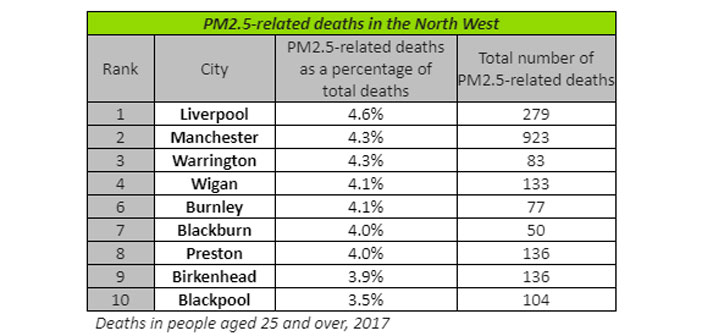A NEW report has ranked Warrington third worst in the North West for deaths from “deadly toxins,” with death from air pollution now 21 times higher than deaths from traffic accidents.
Warrington has already recognised the importance of good air quality for health and in areas that exceed national standards, they have declared Air Quality Management Areas and have produced an Air Quality Action Plan.
More than one in 23 deaths in the North West’s largest cities and towns are now related to long term exposure to air pollution, according to new estimates in Centre for Cities’ annual study of the UK’s major urban areas – Cities Outlook 2020. That’s 21 times the regional rate of deaths from traffic accidents.
The proportion of deaths related to the deadly toxin PM2.5 are highest in Liverpool, with the latest data linking it to 279 deaths in just one year, or 4.6% of all adult deaths in the city.
Cities and large towns in the North West have the largest numbers of estimated PM2.5 related deaths in the UK outside London – 1921 deaths in total.
Blackpool has the smallest proportion of deaths related to PM2.5 in England, and fourth smallest in the UK. There, PM2.5 caused 104 deaths – or 3.5% of all adult deaths in the city.
These deadly levels of PM2.5 are currently legal in England, Wales and Northern Ireland, despite breaking the World Health Organization’s air pollution guidelines.
Transport is a significant, but not sole contributor to air pollution; burning fuels is also a major cause. For example, half of deadly PM2.5 toxins generated in cities and large towns come from sources such as wood burning stoves and coal fires. Not all of it is locally generated – some in the south of England is blown in from continental Europe.
The proportion of deaths related to the deadly toxin PM2.5 is highest in cities and large towns in south eastern England such as Slough, Luton and London, where an estimated one in 16 people die from exposure.
Half of local authority leaders polled by Centre for Cities highlighted the environment as a major concern, but progress has been slow and they must do more to prevent more avoidable deaths from air pollution. Cities in the North West should:
Introduce Ultra Low Emission Zones to charge car and van drivers in city centres. Ban the use of wood burning stoves and coal fires in areas where air pollution exceeds guidelines.
Meanwhile, the UK Government should do more to help politicians in the North West act. It should:
Adopt the WHO’s stricter guidelines on PM2.5 – as the Scottish Government has already done – and make a legally binding commitment to meet this by 2030 at the latest.
Triple the size of the Clean Air Fund to £660 million to help cities fight air pollution.
Provide financial incentives for cities to improve air quality through the establishment of an Environmental Impact Bond.
Make securing plans with the EU to tackle cross border air pollution a key component of the future relationship.
Andrew Carter, Chief Executive of Centre for Cities, said: “More than half of people in the UK live in cities and large towns. And while they offer people good employment and lifestyle opportunities Cities Outlook 2020 shows that they also having a damaging effect on their health, with air pollution killing thousands of people living in cities every year.
“Politicians often talk tough on addressing air pollution but we need to see more action. People in the North West should be at the centre of the fight against its toxic air and councils should take the steps needed, including charging people to drive in city centres and banning wood burning stoves.
“To help the Government needs to provide the North West’s councils with extra money and introduce stricter guidelines. The deadly levels of polluted air in the North West are entirely legal. This needs to change. As a matter of urgency the Government should adopt WHO’s stricter guidelines around PM2.5 emissions. Failure to act now will lead to more deaths in the North West.”
A Warrington Borough Council spokesperson said: “We recognise the importance of good air quality for health.
“In Warrington, where there are areas that exceed national standards, we have declared Air Quality Management Areas and have produced an Air Quality Action Plan. This Plan sets out a series of measures to improve air quality, not just within the management areas but across the wider borough.
“We also produce regular reports on the latest monitoring data and provide updates on the progress of the Action Plan. In addition, our new Local Transport Plan (LTP4) includes transport measures to reduce air emissions.
“There is significant evidence of the health impacts from poor air quality, in particular exposure to very fine particles in the air; known as PM2.5. We are one of the few local authorities with the ability to monitor for these and we have produced a local health assessment. Currently there are no set limits for PM2.5 at a local level and the World Health Organization (WHO) limit is a guideline value only. The Government has produced a new draft Environment Bill and has indicated that the WHO value will be brought in by 2022 as a national standard, to be met by 2030.
“The Council is a member of the UK100 cities group and signed up to their Clean Air Declaration setting out a number of “asks” to central government to improve air quality. These include providing additional resources to improve air quality and the adoption of the WHO value for PM2.5.”
Background:
The Annual Status Report and the Air Quality Action Plan can be viewed on www.warrington.gov.uk/airquality
The Local Transport Plan is available on https://www.warrington.gov.uk/LTP4
The Joint Needs Strategic Assessment can be viewed on https://www.warrington.gov.uk/jsna
UK100 https://www.uk100.org/clean-air/
About PM2.5
Particulate matter (PM) is a mixture of solid particles and liquid droplets in the air. It can be either human-made or naturally occurring. Examples include dust, ash and sea-spray. PM2.5 means the mass per cubic metre of air of particles with a size (diameter) generally less than 2.5 micrometres (µm).
Inhalation of PM2.5 can negatively affect health and there is no safe threshold below which no adverse effects would be anticipated.
The biggest impact of particulate air pollution on public health is understood to be from long-term exposure to PM2.5, which increases the age-specific mortality risk, particularly from cardiovascular causes.





2 Comments
Only to be expected when WBC seems hell bent on surrounding the borough with logistics depots, some at the expense of the town’s “natural lung” the green belt. And, to make matters worse, create Port Warrington virtually in the centre of the town, which will bring HGVs and their attendant pollution into closer contact with the people.
Hmm. Is this the same WBC which included Peel Hall in its Local Plan? Putting 1,200 homes and a care home for the elderly at the heart of the town’s 2 Air Quality Management Areas?
I just don’t believe their propaganda.